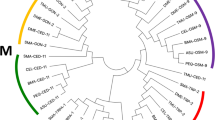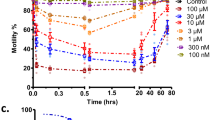Abstract
Ascaris lumbricoides, a round worm commonly found in the intestine of pig, has been used as an isolated muscle preparation for the investigation of anthelminthic potency1. We are now making a wider assessment of Ascaris as a pharmacological tool. Responses were recorded from a length of dorsal muscle, cut from the anterior region of the worm, mounted in an organ bath containing modified Tyrode's solution at 37° C (refs. 2 and 3). In our experiments the most striking pharmacological effects have been seen with γ-aminobutyric acid (GABA), which produced a rapid reversible inhibition of Ascaris muscle, reflected as a relaxation of the preparation, in concentrations as low as 0.5 µg/ml. The time required for full development of relaxation at this concentration is 3–4 min. In contrast, the common anthelminthic agent piperazine produces a much slower relaxation (more than 10–15 min) at concentrations of the order of 50 µg/ml. Similar relative concentrations of GABA and piperazine have been shown to depress spike potentials in Ascaris muscle4,5.
This is a preview of subscription content, access via your institution
Access options
Subscribe to this journal
Receive 51 print issues and online access
$199.00 per year
only $3.90 per issue
Buy this article
- Purchase on Springer Link
- Instant access to full article PDF
Prices may be subject to local taxes which are calculated during checkout
Similar content being viewed by others
References
Baldwin, E., Parasitol., 35, 89 (1943).
Baldwin, E., and Moyle, V., J. Exp. Biol., 23, 277 (1947).
Goodwin, L. G., Brit. J. Pharmacol., 13, 197 (1958).
del Castillo, J., de Mello, W. C., and Morales, T., Experientia, 20, 141 (1964).
Jarman, M., J. Physiol., 173, 35P (1964).
Hobbiger, F., J. Physiol., 142, 147 (1958).
Hobbiger, F., J. Physiol., 144, 349 (1958).
Elliott, K. A. C., and Florey, E., J. Neurochem., 1, 181 (1956).
del Castillo, J., de Mello, W. C., and Morales, T., Arch. Intern. Physiol., 71, 741 (1963).
Elliott, K. A. C., and Jasper, H. H., Physiol. Rev., 39, 383 (1959).
Fairbairn, D., Exp. Parasitol., 6, 491 (1957).
Author information
Authors and Affiliations
Rights and permissions
About this article
Cite this article
ASH, A., TUCKER, J. Inhibition of Ascaris Muscle by γ-Aminobutyric Acid: a Possible New Assay Method. Nature 209, 306–307 (1966). https://doi.org/10.1038/209306a0
Issue Date:
DOI: https://doi.org/10.1038/209306a0
Comments
By submitting a comment you agree to abide by our Terms and Community Guidelines. If you find something abusive or that does not comply with our terms or guidelines please flag it as inappropriate.



